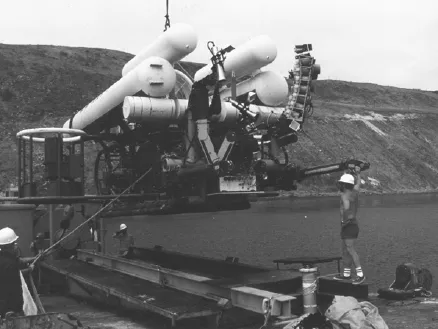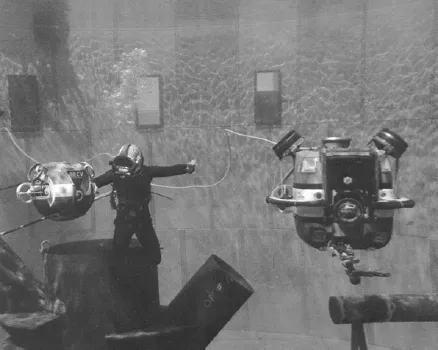1.1 INTRODUCTION
The strange thing about history is that it never ends. In the case of Remotely Operated Vehicles (ROVs), that history is a short one, but very important nonetheless, especially for the observation-class ROVs.
Two critical groups of people have driven ROV history: (1) Dedicated visionaries and (2) exploiters of technology. Those who drove the development of ROVs had a problem to solve and a vision, and they did not give up the quest until success was achieved. There were observation-class vehicles early in this history, but they were far from efficient. In time, however, the technology caught up with the smaller vehicles, and those who waited to exploit this technology have led the pack in fielding smaller, state-of-the-art ROVs.
This section will discuss what an ROV is, address some of the key events in the development of ROV technology, and address the breakthroughs that brought observation-class ROVs to maturity.
1.2 WHAT IS AN ROV?
Currently, underwater vehicles fall into two basic categories (Figure 1.1): Manned Underwater Vehicles and Unmanned Underwater Vehicles (UUVs). The US Navy often uses the definition of UUV as synonymous with Autonomous Underwater Vehicles (AUVs), although that definition is not a standard across industry.
According to the US Navy’s UUV Master Plan (2004 edition, section 1.3), an ‘unmanned undersea vehicle’ is defined as a:
Self-propelled submersible whose operation is either fully autonomous (pre-programmed or real-time adaptive mission control) or under minimal supervisory control and is untethered except, possibly, for data links such as a fiber-optic cable.
The civilian moniker for an untethered underwater vehicle is the AUV, which is free from a tether and can run either a pre-programmed or logic-driven course. The difference between the AUV and the ROV is the presence (or absence) of direct hardwire communication between the vehicle and the surface. However, AUVs can also be linked to the surface for direct communication through an acoustic modem, or (while on the surface) via an RF (radio frequency) and/or optical link. But in this book, we are concerned with the ROV.
Simplistically, an ROV is a camera mounted in a waterproof enclosure, with thrusters for maneuvering, attached to a cable to the surface over which a video signal is transmitted (Figure 1.2). Practically all of today’s vehicles use common consumer industry standards for commercial off-the-shelf (COTS) components. The following section will provide a better understanding of the scope of this definition.
1.3 IN THE BEGINNING
One way to discuss the historical development of ROVs is to consider them in terms of the cycle of life – from infancy to maturity. Anyone who has raised a child will quickly understand such a categorization. In the beginning the ROV child was ‘nothing but a problem: Their bottles leaked, their hydraulics failed, sunlight damaged them, they were too noisy and unreliable, were hard to control and needed constant maintenance. Beginning to sound familiar?’ (Wernli, 1998).
Some have credited Dimitri Rebikoff with developing the first ROV – the POODLE – in 1953. However, the vehicle was used primarily for archeological research and its impact on ROV history was minimal – but it was a start.
Although entrepreneurs like Rebikoff were making technology breakthroughs, it took the US Navy to take the first real step to an operational system. The Navy’s problem was the recovery of torpedoes that were lost on the seafloor. Replacing a system that essentially grappled for the torpedo, the Navy (under a contract awarded to VARE Industries, Roselle, New Jersey) developed a maneuverable underwater camera system – a Mobile Underwater Vehicle System. The original VARE vehicle, the XN-3, was delivered to the Naval Ordnance Test Station (NOTS) in Pasadena, California, in 1961. This design eventually became the Cable-Controlled Underwater Research Vehicle (CURV).
The Navy’s CURV (and its successor – CURV III) made national headlines twice:
• The CURV retrieved a lost atomic bomb off the coast of Palomares, Spain in 1966, from 2850 feet (869 meters) of water, even though working beyond its maximum depth. The CURV’s sister vehicle, CURV II, is shown in Figure 1.3.
• CURV III, which had become a ‘flyaway’ system, was sent on an emergency recovery mission from San Diego to a point offshore, near Cork, Ireland in 1973. With little air left for the two pilots of the PISCES III manned submersible, which was trapped on the bottom in 1575 feet (480 meters) of water, the CURV III attached a recovery line that successfully pulled the doomed crew to safety.
With such successes under its belt, the Navy expanded into more complex vehicles, such as the massive Pontoon Implacement Vehicle (PIV), which was developed to aid in the recovery of sunken submarines, shown with the integrated Work Systems Package (WSP) (Figure 1.4).
At the other end of the scale, the US Navy developed one of the very first small-size observation ROVs. The SNOOPY vehicle, which was hydraulically operated from the surface, was one of the first portable vehicles (Figure 1.5).
This version was followed by the Electric SNOOPY, which extended the vehicle’s reach by going with a fully electric vehicle. Eventually sonars and other sensors were added and the childhood of the small vehicles had begun.
Navy-funded programs helped Hydro Products (San Diego, CA) get a jump on the ROV field through the development of the TORTUGA, a system dedicated to investigating the utility of a submarine-deployed ROV. These developments led to Hydro Products’ RCV line of ‘flying eyeball’ vehicles (Figure 1.6).
These new intruders, albeit successful in their design goals, still could not shake that lock on the market by the manned submersibles and saturation divers. In 1974, only 20 vehicles had been constructed, with 17 of those funded by various governments. Some of those included:
• France – ERIC and Telenaute and ECA with their PAP mine countermeasure vehicles.
• Finland – PHOCAS and Norway – the SNURRE
• UK – British Aircraft Corporation (BAC-1) soon to be the CONSUB 01; SUB-2, CUTLET
• Heriot-Watt University, Edinburgh – ANGUS (001, 002, and 003)
• Soviet Union – CRAB-4000 and MANTA vehicles.
It could be said that ROVs reached adolescence, which is generally tied to a growth spurt, accented by bouts of unexplained or irrational behavior, around 1975. With an exponential upturn, the number of vehicles grew to 500 by the end of 1982. And the funding line also changed during this period. From 1953 to 1974, 85 percent of the vehicles built were government funded. From 1974 to 1982, 96 percent of the 350 vehicles produced were funded, constructed, and/or bought by private industr...






